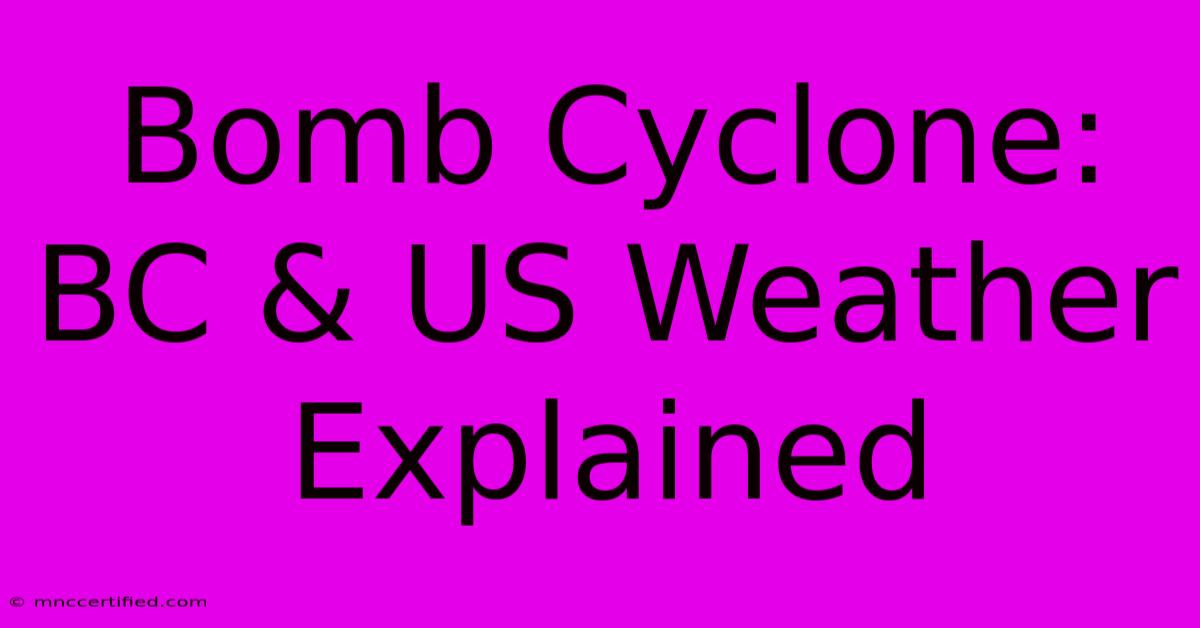Bomb Cyclone: BC & US Weather Explained

Table of Contents
Bomb Cyclone: BC & US Weather Explained
A "bomb cyclone" sounds like something out of a disaster movie, and while it can certainly cause significant disruption, understanding the meteorology behind it demystifies the fear. This article will delve into the science of bomb cyclones, focusing on their formation, impact on weather patterns in both British Columbia (BC) and the United States, and the crucial differences between a bomb cyclone and a regular storm.
What is a Bomb Cyclone?
A bomb cyclone, also known as bombogenesis, is a rapidly intensifying mid-latitude cyclone. The key characteristic is its incredibly fast pressure drop. Specifically, it's defined by a central pressure that falls at least 24 millibars (mb) in 24 hours. This rapid intensification is fueled by a combination of atmospheric instability and favorable upper-level atmospheric conditions. Think of it as a weather system on steroids, accelerating its power much faster than a typical storm.
Bombogenesis: The Process
Several factors contribute to bombogenesis:
- Cold Air Mass: A significant cold air mass at the surface is crucial. This provides the necessary temperature contrast with warmer, moist air.
- Warm, Moist Air: The presence of warm, moist air, often originating from a relatively warmer body of water like the ocean, provides the fuel for the storm's intensification. The moisture is key to producing heavy precipitation.
- Upper-Level Support: A strong upper-level trough, or dip in the jet stream, is essential. This upper-level pattern helps to lift the moist air upward, driving the storm's development. This lifting is what intensifies the low-pressure system.
- Baroclinic Instability: This is a complex meteorological phenomenon where differences in temperature and pressure gradients lead to instability and the formation of cyclonic vorticity (rotating winds).
Bomb Cyclones in British Columbia (BC)
While less frequent than in some other regions, BC is susceptible to bomb cyclones, particularly along its coast. The interaction of cold Arctic air masses with the relatively warmer waters of the Pacific Ocean creates the necessary ingredients. These storms can bring:
- Heavy Snowfall: Significant snowfall accumulation in mountainous regions, causing transportation disruptions and potential avalanches.
- High Winds: Strong winds along the coast and inland, leading to power outages and property damage.
- Coastal Flooding: Storm surges combined with high tides can cause coastal flooding in low-lying areas.
Bomb Cyclones in the United States
The US, particularly the eastern seaboard and the Great Lakes region, experiences more frequent and impactful bomb cyclones. The interaction between cold Arctic air and the relatively warmer waters of the Atlantic Ocean, and to a lesser extent the Great Lakes, is a major driving force. These storms can cause:
- Blizzards: Severe blizzards with heavy snowfall, strong winds, and reduced visibility.
- Coastal Erosion: Intense waves and storm surges causing significant coastal erosion.
- Severe Flooding: Heavy rainfall and snowmelt can lead to widespread flooding.
- Power Outages: High winds and heavy snow can cause widespread power outages affecting millions.
Bomb Cyclone vs. Regular Storm: Key Differences
The primary difference lies in the rate of intensification. A bomb cyclone intensifies much faster than a typical extratropical cyclone. While a regular storm might develop gradually over several days, a bomb cyclone's rapid pressure drop leads to significantly more intense weather conditions in a shorter timeframe. This speed is the defining characteristic that makes a bomb cyclone stand out.
Predicting and Preparing for Bomb Cyclones
Accurate forecasting of bomb cyclones remains a significant challenge, although advancements in meteorological modeling are improving prediction accuracy. Monitoring weather forecasts from reputable sources like the National Weather Service (US) and Environment Canada (Canada) is crucial. Preparation includes:
- Emergency Kits: Having emergency supplies readily available, including food, water, and medications.
- Staying Informed: Monitoring weather reports closely and following official advisories.
- Securing Property: Taking steps to protect your home and property from potential damage.
In conclusion, bomb cyclones are powerful and rapidly intensifying weather systems that can have devastating consequences. Understanding their formation and potential impacts is critical for both mitigating risks and ensuring community safety in both BC and the United States. Staying informed and prepared is the best defense against these meteorological behemoths.

Thank you for visiting our website wich cover about Bomb Cyclone: BC & US Weather Explained. We hope the information provided has been useful to you. Feel free to contact us if you have any questions or need further assistance. See you next time and dont miss to bookmark.
Featured Posts
-
Pams Nomination Msnbc Guests Surprise
Nov 23, 2024
-
Bonding Insurance For Nonprofit
Nov 23, 2024
-
Is Qutenza Covered By Insurance
Nov 23, 2024
-
Pam Bondi Trumps Justice Pick
Nov 23, 2024
-
Viewers Angry At Luke Evans Saturday Kitchen
Nov 23, 2024